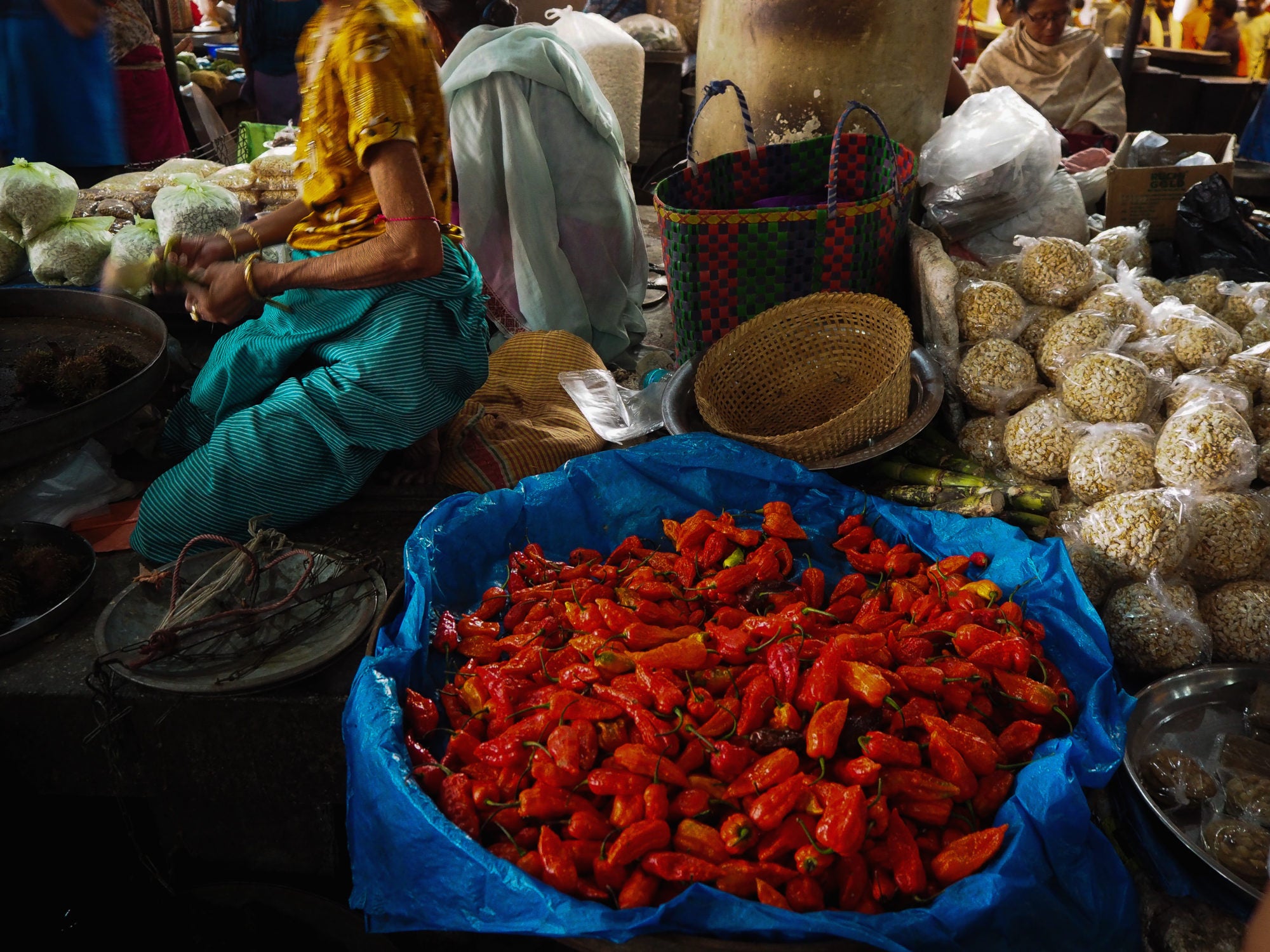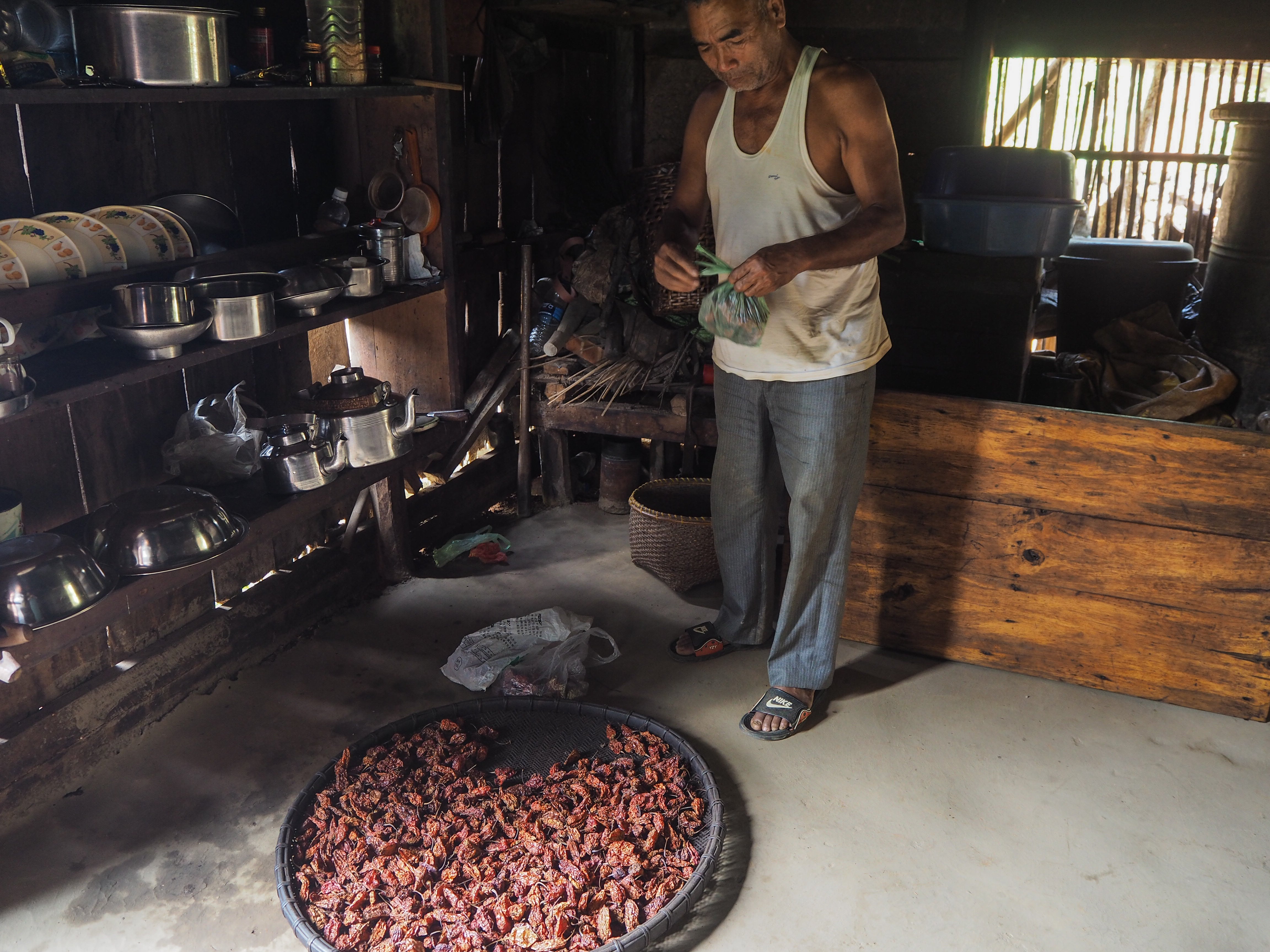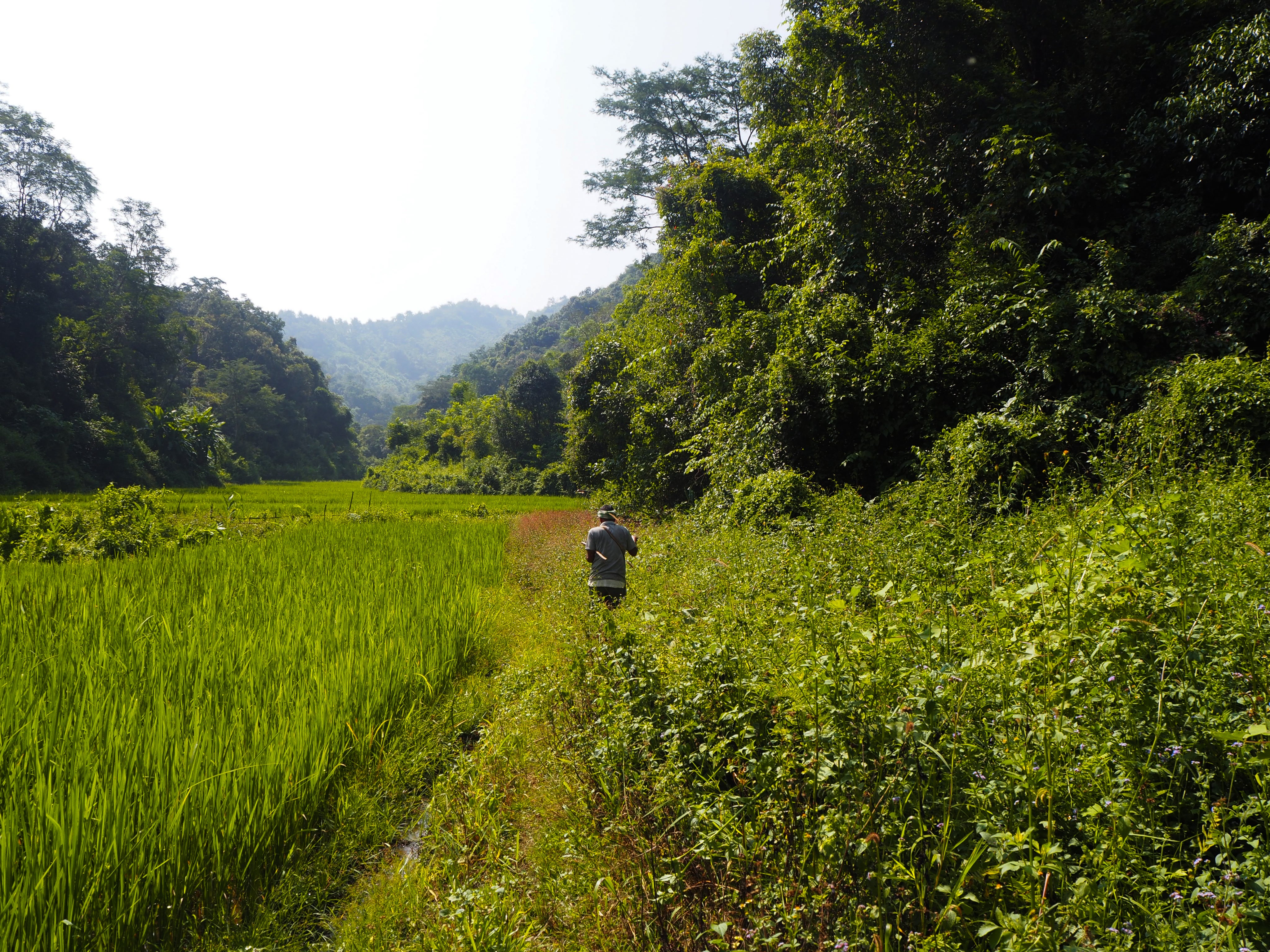
In the West, where it’s called the ghost pepper, the king chile is synonymous with scorching heat and show-off frat boys. In Northeast India, it is a way of life and a means of survival.
The king chile is everywhere at the Ima Keithel. Located in Imphal, the capital of the Northeast Indian state of Manipur, it’s the world’s largest women-run marketplace—and also a de facto showcase for the chile, which sits in large, flaming-red piles on blue tarpaulin where it has been set out to dry.
“Right now, in October, it is in season, so everyone will want to buy it fresh,” says Luxmi Salam, a researcher based in Imphal, as she scours stalls for the fattest chiles. “Soon it will be time to pickle it and dry it, to be eaten year round.”
The king chile is known by many names in northeast India: bhut jolokia in Assam, u-morok in Manipur, raja-mircha in Nagaland. Its size, texture, and heat level differ in each region where it is grown, but it is always plump and smooth, typically as long as an index finger, and can be distinguished by its glossy, saturated red color and acrid penetrative smell. This pungency divides the loyalists from the naysayers, but everyone agrees that the chile possesses layers of flavor that are expressed differently when it is pounded, sliced, or fermented. But in the United States, where the chile is known widely as the ghost pepper, it’s infamous for its fire, not its flavor: It clocks in at over 1 million units on the Scoville Scale, which is used to measure heat in peppers. In 2007, Guinness World Records crowned the chile the world’s hottest.
Since then it has become the stuff of stunts and party tricks; the ghost pepper is particularly popular with culinary daredevils—frat boys (and aging frat men) who make YouTube videos of themselves eating chiles and suffering the consequences, which typically include vomiting and headaches—and, in one case, a ruptured esophagus.
But in India’s eight northeastern states, the chile has been a way of life for generations; it prevailed even during the more than five decades of violent ethnic conflicts and insurgencies that plagued the region, which is populated by 225 ethnic tribes. It’s a land of plush rolling hills and astounding diversity and is further distinguished from India’s mainland by race and language, as well as cuisine and palate. Typical Indian staples like turmeric, jaggery, garam masala, and yogurt are absent in the kitchens of Northeast India. But the king chile makes its way into many dishes, whether it’s stirred into stews, chopped up into condiments, or scattered over meat.
“Centuries,” says Chun Gangmei when I ask how long her family has been eating the chile. Chun is a member of the Kabui Naga, one of Manipur’s 33 tribes, and lives in Neikanlong, a village at Imphal’s foothills. “Spices are not part of our foods,” she says as she peels a squash and stuffs fatty pork in bamboo. “Historically, hill tribes did not have access to oil, which is needed to cook spices. So the king chile is indispensable to us. Without it, our dinner would not take place.”
While Chun was unaware of the chile’s Guinness record, she isn’t surprised to learn of it. “All you need is a blot,” she says as she slices the chile into an iromba, or chutney made with dried river fish and herbs. “To eat too much of the king chile would be a foolish thing to do.”
The origins of the chile can symbolically be traced back to the Kuki-Chin tribes, according to Dr. Satkai Chongloi, a Kuki anthropologist. We’re driving to Khomunnom, a Kuki village in Manipur’s northeastern Ukhrul district. “It goes back to the early days of the tribe wherein the Kukis would tie the chile to a burning log of wood and send it to a village to declare war.”
The Kuki inhabit the hill tracts of Bangladesh, Myanmar, and India; in the tribe’s language, the chile is called the malcha-pom, which translates amusingly to “Help, the chile is swollen!” On the hills of Ukhrul, where warmth is sufficient and rain is scarce, the chile lives a full life.
“Without the malcha there is no Kuki,” says Thanglen Chongloi, a farmer from Khomunnom. “Without the Kuki there is no malcha.”
Thanglen is one of the 300 family elders in his village, one of just a few who have planted the crop. His chiles grow for only six weeks in October and November, during which he harvests, dries, and pickles them. Both Thanglen and his wife, Nengkholam, farm their land of more than 2,000 plants; at least 40 full chiles sprout from each one.
“Once we’re done picking the malchas, we will store them for the rest of the year,” says Nengkholam as she collects 10 for our lunch. “How do you eat so much, you may ask, but it is in our blood—if we don’t feed it in, something will go wrong.”
As Thanglen sorts the dried chiles, Nengkholam mashes three for an-kam-thu, a fragrant condiment made with mustard seeds and chile that serves as both as an appetite stimulant and a digestive. On the table are malcha-meh, a standard smashed side of stringy dried pork and chile; steamed rice; and a thick stew of wild boar and yam, the meal’s celebratory dish. “The malcha is an everyday custom since I was a little girl,” Nengkholam says. “I cannot remember a day without it.”
The chile is a common presence in the tribe’s meals and also has a place in its recent history. In 1917, when the Kukis engineered their first war of independence against the British imperials, the chile’s heat became a symbol of resistance.
After the war weakened the Kukis economically, they became resentful of the neighboring Tangkhuls for not having come to their aid against the British. In the early 1990s, intertribal rancor resulted in an ethnic cleansing that killed more than 1,000 Kukis. Today, although relative peace prevails in the jungles, emotions remain strained. And so for the Kukis, the chile has become a way to reclaim their narrative in the region. It has continued to guard their lands, lend color to bleak times, and help keep their identity alive.
In Kohima, the capital city of Manipur’s neighboring state of Nagaland, a Naga writer named Rovi Chasie pierces fresh king chiles for pickling. “In my village, in Khonoma, it is considered taboo to eat the leaves of the king chile’s plant,” Rovi says. “But it is because the plant cannot grow without its leaves. The taboo was designed to make the plant last forever.”
Nagaland is home to numerous tribes that are so distinct in their customs and languages that they are incomprehensible to one another. While the chile has a different name in each tribe, its most common term in Nagaland is raja mircha.
“An important thing to know about the chile is that it has a short shelf life, and it rots easily if water hits it,” says Rovi, who belongs to the Angami tribe. “So when I pickle it, I wipe each chile with a damp cloth, spice them with a Bengali panch-phoran [five-spice mix] and put them in mustard oil.”
Each region in Nagaland produces a chile that tastes and looks different. Some farmers use additives and pesticides, but others rely on the quality of the soil, and what Vizokhoü Maire, an Angami farmer from Zeizou village, calls “the wisdom of their forefathers.”
In Zeizou, the chile is called kocha chishi, or the chile of the Kukis, and is said to have been brought by a chieftain after he raided a Kuki village many centuries ago. The Nagas are warriors, with a cuisine formed through victories and symbols of valor. While they credit the chile’s origin to the Kukis, they believe that through virtue and the diligent acquisition of lands by their forefathers, it also belongs to them.
“You see how it has bumps,” says Vizokhoü, running her index finger along the chiles that grow from her plants. “In other parts of Nagaland, they grow them to be pretty and sleek, but if it has these bulges, that means it has more flavor, both sweetness and spice.”
Big, bulging, and the brightest red in these parts, Zeizou’s chile is one of the most sought after at the marketplace. In the village, almost every farmer who has plants cultivates them. Vizokhoü sells her produce to market sellers, but packages most to sell to retailers at the Hornbill Festival, Nagaland’s annual December showcase of its tribes’ cultures. “I sent my kids to college with the raja,” she says. “My yams and rice don’t get me quite enough.”
“Every raja has a different temperament and taste; it is not just about heat,” says Vizokhoü’s nephew Petevezai Theünuo as his aunt smashes the chile into ta-thou, a chutney made with shallots, tree tomatoes, garlic, and herbs. “This one is also a bit sweet; it goes well with charred, dry, meat and black rice.”
As she tastes her ta-thou, its heat makes Vizokhoü sputter and gasp. This is how it should taste, she explains. “Like something vital—like fire, or the sun.”
“Look down, all your food will have a slight taint of the raja,” she adds, pointing to a red tint spreading over her plate. “Dal, vegetables, meat: When the raja is on the table, it trumps them all.”
For young Northeastern tribals, the king chile provides a way for them to take part in India’s metropolitan food culture; in doing so, it gives a voice to those otherwise neglected in the narrative of Indian cuisine.
“After the insurgencies and civil wars, Ukhrul has been hit by isolation,” says Zeinorin Stephen, a Tangkhul Naga from Ukhrul and the founder of Hill Wild Chocolates. “As young tribals, many of us are not interested in the wars the elders waged. The chile can be used as a unifying force, to give the region a voice.”
Like Zeinorin, other young Indians with roots in the Northeastern tribes are looking to the chile as a way to introduce their food to a mainstream audience. One New Delhi restaurant serves pork ribs smoked in the chile, while others have begun to serve momos with a chile-laced sauce. The king chile has also infiltrated the world of hot sauces, with companies like Chuka in Nagaland bottling and selling it to suppliers across India and New Delhi–based Wingreens, which has created a Sriracha sauce from the chile.
For tribals of the diaspora, who live at the intersection of strong tradition and inescapable modernity, the chile is a prism through which they can view their history, and a way to assert their identity while moving forward in the world. “I am putting it in a bottle and selling it with fermented soya bean,” says Lulu Gangmei, the owner of a Naga food truck in Belgium. “I thought people would hate it! But the raja mircha has a taste distinctive [from] anything else. Which is why it stands out. In a way, it makes us stand out as well.”
“It is now a global food,” says Dolly Kikon, an anthropologist of Naga origin based in Melbourne. “To me, the king chile is not just associated with the notion of memory, like it belongs in the past; its spiciness is such an experience of the present and now. It is how I relate to the food around me.”
When I tell Thanglen about how the chile’s heat has made it YouTube fodder in the United States and beyond, he is unimpressed. “The malcha comes from the land, and the land was here first,” he says. “Why would you try and fight something older and wiser than yourself?”
Indigenous food cultures may now be in vogue in the West, but in the forests of Manipur and the mountains of Nagaland, the king chile is a reminder that spice is a matter of taste, as well as a method of survival. And like the region’s people, it doesn’t pander to those who aim to tone it down.
“Everyone thinks chiles are about hotness, but they are about much more,” says Thanglen. “Life is difficult here these days. Maybe our ancestors knew that hard times would come. So they gave us the malcha. And we will put it in meat, grind it to juicy fat pieces for iromba. So when times get difficult, it will keep us safe.”
He packs up some chiles for his guests to take home. “It will keep us here,” he says, “where we belong.”







